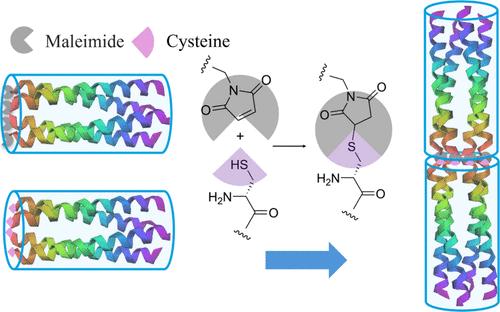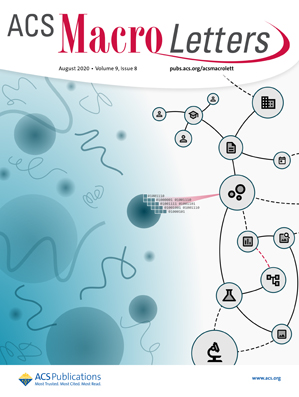由计算设计的平行线圈构件制成的均匀短棒的液晶行为
IF 5.2
Q1 POLYMER SCIENCE
引用次数: 0
摘要
利用 29 个氨基酸肽计算设计出平行的同四聚体盘绕线圈。这些平行盘卷被称为 "bundlemers",具有 C2 对称性,所有 N 端都从纳米粒子的一端显示,所有 C 端则从另一端显示。肽末端的这种各向异性显示使两组纳米粒子在组成肽的 N 端区域具有马来酰亚胺或硫醇功能。互补束聚物纳米粒子 N 端之间的硫醇-迈克尔共轭反应形成了单分散的刚性束聚物二聚体,称为 "双束聚物"。利用小角 X 射线散射 (SAXS)、佛斯特共振能量转移 (FRET) 和圆二色性 (CD) 光谱对组成的单个束聚合物纳米粒子进行了表征,以确认盘绕线圈的平行组装与计算设计一致。利用 SAXS 对二束聚合棒进行了表征,揭示了二束聚合棒的均匀性。通过偏振光学显微镜 (POM) 观察,在棒状物的浓缩样品中观察到了光学双折射,揭示了向列液晶行为。本文章由计算机程序翻译,如有差异,请以英文原文为准。

Liquid Crystal Behavior of Uniform Short Rods Made from Computationally Designed Parallel Coiled Coil Building Blocks
Parallel, homotetrameric coiled coils were computationally designed using 29 amino acid peptides. These parallel coiled coils, called “bundlemers”, have C2 symmetry, with all N-termini displayed from one end of the nanoparticle and all C-termini from the opposite end. This anisotropic display of the peptide termini allowed for the functionalization of two sets of nanoparticles with either maleimide or thiol functionality at the N-terminal region of the constituent peptides. The thiol-Michael conjugation reaction between the N-terminal end of complementary bundlemer nanoparticles formed monodisperse, rigid bundlemer dimer, called “dibundlemer”, rods. The constituent, individual bundlemer nanoparticles were characterized with small-angle X-ray scattering (SAXS), Förster resonance energy transfer (FRET), and circular dichroism (CD) spectroscopy to confirm the parallel assembly of the coiled coils, consistent with the computational design. The dibundlemer rods were characterized with SAXS to reveal the uniform dibundlemer nature of the rods. Optical birefringence is observed in concentrated samples of the rods, with polarized optical microscopy (POM) revealing a nematic liquid crystalline behavior.
求助全文
通过发布文献求助,成功后即可免费获取论文全文。
去求助
来源期刊
CiteScore
10.40
自引率
3.40%
发文量
209
审稿时长
1 months
期刊介绍:
ACS Macro Letters publishes research in all areas of contemporary soft matter science in which macromolecules play a key role, including nanotechnology, self-assembly, supramolecular chemistry, biomaterials, energy generation and storage, and renewable/sustainable materials. Submissions to ACS Macro Letters should justify clearly the rapid disclosure of the key elements of the study. The scope of the journal includes high-impact research of broad interest in all areas of polymer science and engineering, including cross-disciplinary research that interfaces with polymer science.
With the launch of ACS Macro Letters, all Communications that were formerly published in Macromolecules and Biomacromolecules will be published as Letters in ACS Macro Letters.

 求助内容:
求助内容: 应助结果提醒方式:
应助结果提醒方式:


